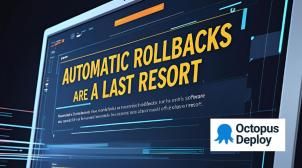Login to your Account
Create Affiliate Account
Trouble Signing In?
Enter your email below to request a Reset Password Link
-
Recruit Wizard scaled and moved to daily deployments with Octopus Cloud
Recruit Wizard transformed its software delivery by adopting Octopus Deploy for full deployment automation across Kubernetes and virtual machines. Moving from quarterly to daily deployments, the team now uses Config as Code and Runbooks to streamline releases, reduce errors, and empower non-engineering staff to run operational tasks independently. With Octopus Cloud, they’ve modernized and scaled their deployments while staying focused on growth and innovation in recruitment software.
-
The ten pillars of pragmatic deployments
Unlock the secrets to flawless software delivery! Explore the "10 Pillars of Pragmatic Deployments" that ensure repeatability, visibility, and auditability. Learn how to master rolling forward, standardize processes, and coordinate releases for robust, high-performing software pipelines.
-
Automatic Rollbacks are a Last Resort
Automatic rollbacks might sound like a safe fallback for failed deployments, but modern software delivery tells a different story. This article explores why human-driven resilience, Continuous Delivery, and progressive delivery strategies are far more effective. Learn how deploying in small batches, using canary or blue/green strategies, and leveraging feature flags can help you respond smarter—and faster—when things go wrong.
-
Stack Overflow Uses Config as Code in Octopus for its Enterprise Solution
Stack Overflow adopted Octopus Deploy to streamline and scale its enterprise software delivery using tenanted deployments, automation, and Configuration as Code. By integrating application code, build, and deployment processes in a single GitHub repo, the team improved CI/CD efficiency, enabled better collaboration through pull requests, and reduced deployment times across multiple customers. Octopus's Azure support, API flexibility, and excellent customer service empowered Stack Overflow to standardize and mature its DevOps practices.
-
Five Reasons Standalone Vulnerability Scanning Isn’t Enough in 2025
Vulnerability scanning alone doesn’t cut it anymore. While it’s long been a core security practice, scanning tools can’t tell you which vulnerabilities are exploitable, how attackers would target them, or which ones pose real risk. This article explores the limitations of vulnerability scanning, the shortfalls of traditional vulnerability management, and why organizations must adopt a risk-based, context-driven approach to application security. Learn how to prioritize based on exploitability, integrate security across the SDLC, and move toward continuous, intelligent threat detection.
-
Mitsubishi UFJ e-Smart Securities Optimizes Package Management and Automates Deployment with JFrog
Mitsubishi UFJ e-Smart Securities has historically faced challenges around optimizing deployment and package management. By adopting the JFrog Software Supply Chain Platform, the company has transformed its approach to DevOps and realized significant improvements in security, efficiency, and speed.
-
Fintech Developer Streamlines Software Production with JFrog’s Release Lifecycle Management
A multinational financial technology firm improved security and compliance by adopting the JFrog Platform for software releases. Using immutable release bundles and controlled promotion, they minimized risks while maintaining strict regulatory standards. JFrog’s Release Lifecycle Management (RLM) capabilities reduced manual intervention, allowing teams to focus on innovation.
-
National Energy Operator’s Journey to DevSecOps Excellence with JFrog
This energy operator and facilitator oversees key national electricity and gas markets. By adopting the JFrog Platform, they transformed their software development operations and security practices, achieving significant operational efficiencies, enhanced security, and millions in cost savings.
-
How to provision certificates for internal services with Teleport Workload Identity
In today's security landscape, relying on firewalls alone is no longer enough. This article explores how Teleport Workload Identity enables secure, short-lived X.509 certificates for internal services using Mutual TLS (mTLS), eliminating long-lived secrets and enhancing workload trust. Learn how to configure and audit mTLS connections between services like NGINX and a client using SPIFFE-compliant certificates, all backed by fine-grained RBAC and detailed audit logging.
-
Fintech Company Streamlines Software Supply Chain Management for Enhanced Security
This leading financial services technology company has significantly improved auditability and traceability, streamlined its security technology tool stack, and strengthened its end-to-end software supply chain security by adopting JFrog Advanced Security.
-
Security Benchmarking Authorization Policy Engines: Rego, Cedar, OpenFGA & Teleport ACD
In collaboration with Teleport, Doyensec has developed the Security Policy Evaluation Framework (SPEF) — a dynamic testing and benchmarking tool for evaluating the security, performance, and reliability of popular authorization policy engines like Rego, Cedar, OpenFGA, and Teleport ACD. Built with modular architecture and containerized execution, SPEF allows researchers and engineers to validate policies under consistent, controlled conditions. This article walks through its architecture, supported engines, and key insights from early testing across 27 threat-driven test cases.
-
Telecommunications Giant Sets the Stage for Scalable, Resilient, and Secure Software Development with JFrog
Learn how this leading multinational telecommunications company transformed its entire development platform, and achieved scalability and optimal uptime by moving to the JFrog Software Supply Chain Platform in the cloud.



















